Instruction Manuals – accessible and for everyone, but now obsolete
Most games in the 80s and 90s came on discs or CD-ROMs in artful cardboard boxes and contained an insightful instruction manual. The printed booklet was essential for teaching how to play the game, telling a story or prologue and making a player familiar with the computer system the game was made for. Instruction manuals were clear and detailed, often even extensive. The Swiss games of the 80s and 90s relied on them as much as any other game. These instruction manuals showed an interesting diversity of approaches from story booklets over cartoons to extensive strategy guides.
Part 3 — From Strategy Guides to Downsizing the printed matter
The extensive Strategy Guides
“Wer am meisten Schnecken besitzt, erhaelt von FatMike einen Preis. Und zwar einen GeldBetrag, oder – bei mindestens 70 Schnecken – ein zusaetzliches Land-Feld! Der oder die Sieger werden angezeigt, danach alle Spieler JOY-KNOPF druecken. […]” (Traders Manual 1990, p.30).
„Who owns the most snails, receives a prize from FatMike. Namely a sum of money, or – with at least 70 snails – an additional land area! The winner(s) will be shown, then all players press JOY-BUTTON. […]“ (translated by author)
Traders (1990) is a game that can keep up with the two clown games mentioned above in terms of humor, but it is an economic simulation game and thus belongs to a genre that is usually very serious and has many realistic components. Not so Traders: Here the goal is to give as many snails as possible generously and voluntarily to the most powerful ruler over all stars, the owner of FAT-STAR, Fat Mike. The science fiction setting is populated with aliens. We can control a so-called ‘plubber’ and have to try to work our way into a good position via trade, all the while paying taxes to Fat Mike, the powerful mutated snail. Markus Grimmer, André Wüthrich and Michael Tschögl have developed a funny trading simulation for LINEL, which is reminiscent of MULE, but very independent.
FAT-STAR, that is the earth in 2000 years, after all dinosaurs and vermin have died out, as the booklet explains on page 4. This future earth is populated by ‘plubbers’, aliens who have traveled here from an alien planet. Snails, on the other hand, are no longer plentiful; finding them is the players‘ task. The booklet is written very colloquially and tries to introduce the players to the story and gameplay with colloquial humor and lightly commenting sentences. It succeeds well. Nevertheless, the manual is comprehensive and includes descriptions of all game areas, sequences, menus as well as farming and trading on a total of 32 pages.
More in line with the genre is Transworld’s (1990) instruction manual by Starbyte. It uses the same format, paper quality and fonts as Rings of Medusa (1989). The glossy cover and back have a slight faded and yellowish look. The whole booklet is printed in black and white with rasterized grey tones on the cover and the inside of the cover that is used to let the player know that they can exchange a defect disk if they send it to Starbyte Software in Bochum (Figure 13). The manual starts on page 4 and continues all the way through the end in written text. There are no graphics, no lists, and no pictures!
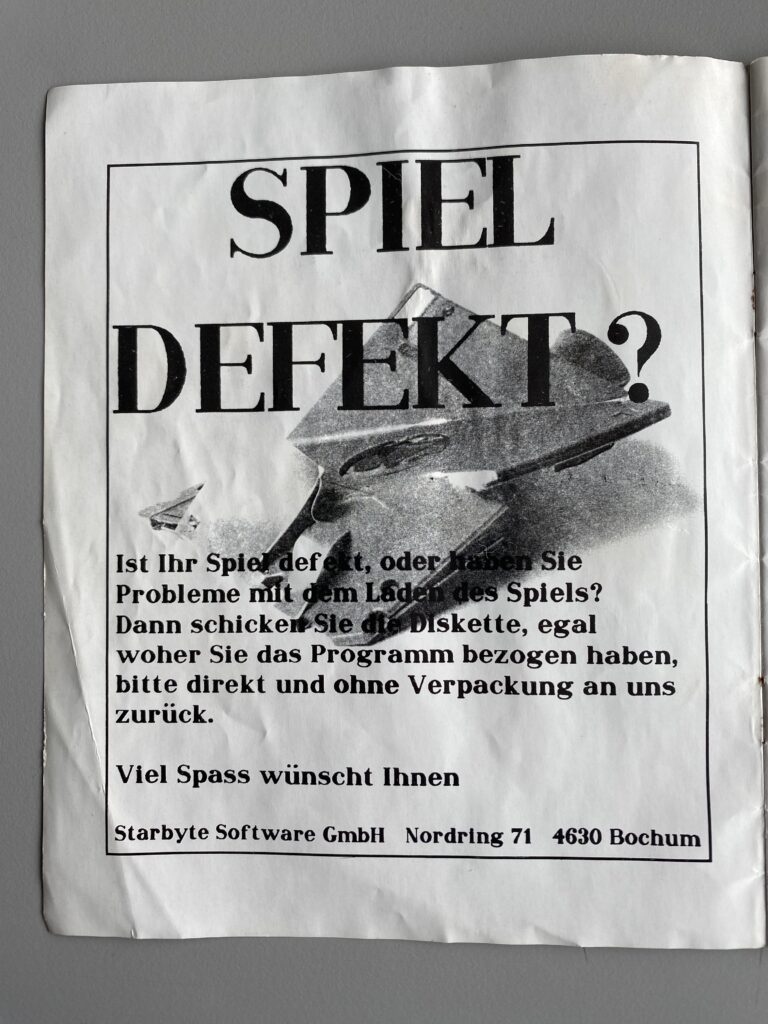
Figure 14: All Starbyte products came with a guarantee to exchange defect discs. Photo: Suter
The chosen topic for the strategy game is somewhat surprising. “You are a young dynamic entrepreneur who is trying to build your own empire in Frankfurt in the area of local and long-distance transport.” (Transworld 1990, p.4) The player gets a starting capital of 50’000 DM and has to build their business with this. The economics and trading simulation is introduced to the player step by step. First with descriptions of the main elements of the game and then with a thorough explanation of all the menu points. Even the goal is a complex one since business success means a certain score that is combined from acquired cash, number of established branches, number of owned trucks and the frequency of punctual deliveries. The fall of the Berlin Wall in 1989 was like a cathartic new beginning for some enterprises. This may have been enough inspiration for the developers to start their transport simulation. But the road to success or failure involving the newly opened part of Europe was difficult. This fact is also recorded in the game.
Striking is the direct addressing of the player in polite form. Like Transworld, the build-up and strategy game Black Gold also uses it to involve the player right away in topic and story of the game. And here too, the player inherits a company that has to be managed well. Becoming a successful capitalist apparently was more than just a dream of young people around 1990. Black Gold’s manual has 48 pages with a textual story and topic introduction on the first four pages. Then the extensive menu points must be explained over the next 22 pages. And after the specifics for the different computer systems, the game can be used with, there is an appendix of 12 pages that shows icons and symbols you encounter in the Ui as small handmade drawings (Figure 14). The last of those pages shows the main menu as a city or area map with the different areas you have to access for extracting coal, refine coal and trade with the commodity.
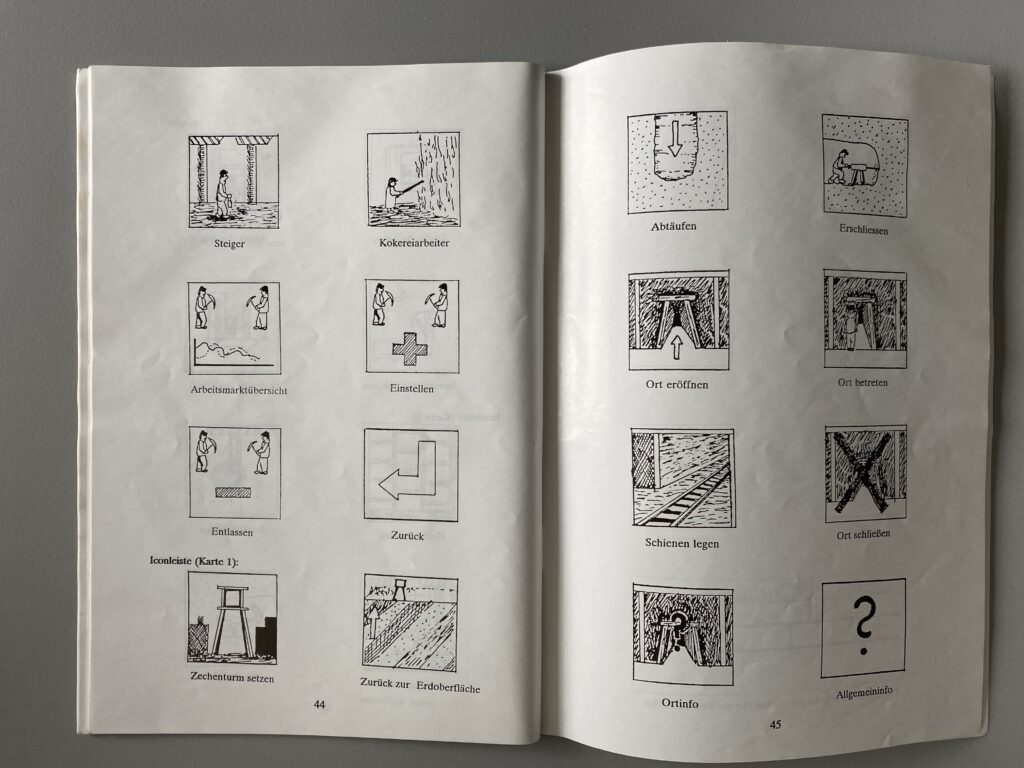
Figure 15: Black Gold’s (1992) manual shows a catalogue of Icon bar buttons. Photo: Suter
In terms of topic, Winzer (1991) is the most surprising strategy game of that time with Swiss participation. The player gets to know that they inherit a vineyard in Germany with a prospective 4 Mio. DM, if they cultivate more wine and take successfully part in a competition with other winemakers. Winemaking as a business game simulation? Quite a fancy occupation. The Cover of the box and the booklet show that it may be the dream of an aspiring millionaire, a successful entrepreneur. The wine is nicely presented as a luxury food item in midst of grapes, the vines in the background are plentyful with a plane (travel) and a woman’s face hovering over them. A mansion on the horizon, a Porsche and a wad of money are awaiting the player and suggest a lavish lifestyle (Figure 16). In the game, however, it’s a long way to get there. and the player has to work through many obstacles.
Winzer’s booklet tries to make you familiar with the wine business and is quite extensive. Story and gameplay options take up 27 of the 32 pages and are addressed to you as a city dweller that accidentally has to become a winemaker. The manual has two unusual features: It comes with two additional leaflets that are designed to help players get into the business faster. An index with explanations of the quality and types of wine. And a table with the minimum Oechsle scale values of the individual grape varieties for wines in the individual regions. The second additional feature of the manual is something that other games at the time used as well: A measure for copy protection. The printed manual had a second use as a password entry tool. At the start of the game, a mask is introduced as copyright protection, which requires a password. The assumption was that a pirated game did not come with a copied manual. The password could be found in the printed booklet bought with the game. The mask asks you to enter the seventh word on page 3 of the manual. And it alternates randomly. If you start the game again, you may have to enter the fifth word on page 6 or the third word on page 17. This was also done for new chapters or new levels. Each time, randomly chosen, you had to enter a certain word on a certain page to continue playing the game. A simple and nifty way of copyright protection with a printed paratext. But nevertheless, if you were part of the gamer community, you found a way to circumvent this measure as well.
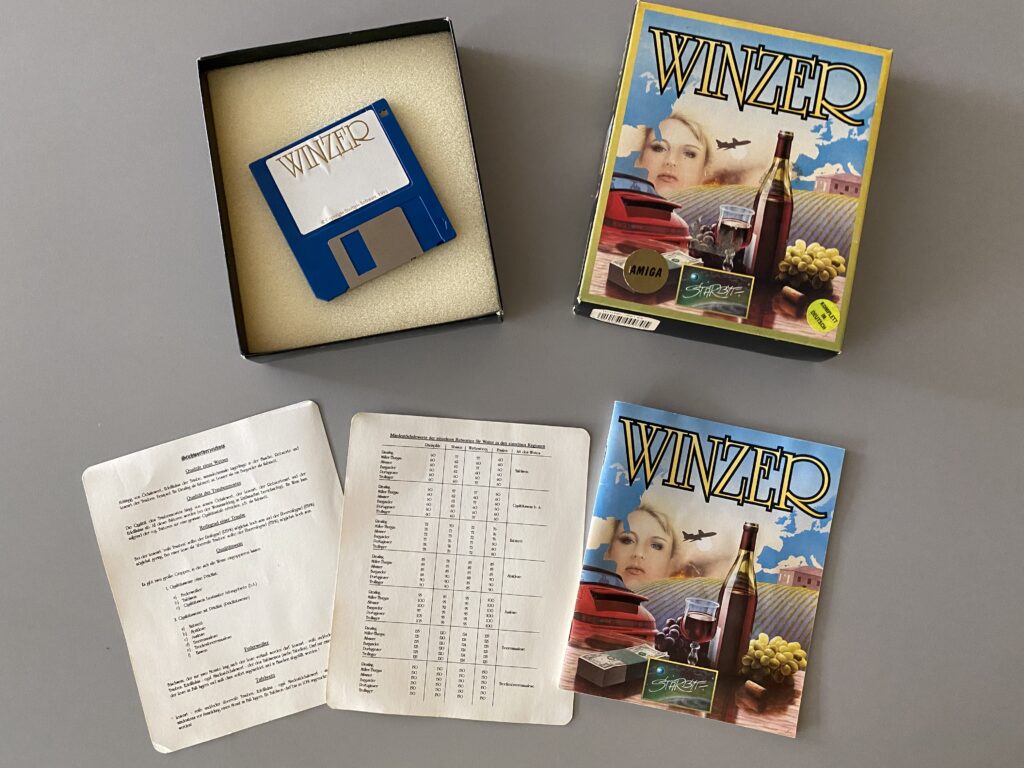
Figure 16: Winzer (1991) is a strategy or economic simulation game with a surprising theme: winemaking. The booklet is accompanied by leaflets making you familiar with the not so familiar business. Photo: Suter
Probably the most comprehensive instruction manual Starbyte provided is the one for the game Space MAX (1992). The successful fictional production begins with a quote from US President Ronald Reagan from 1984 who saw outer space as humanity’s final frontier and as an opportunity for global leadership. Through the 80s, Reagan pumped a lot of money into the space shuttle program and started a decade of high activities in space what eventually led to a permanently manned international space station years later. This political awakening of space discovery mostly in the U.S. inspired Starbyte to build a realistic historical framework for the launch of a large space station by a private company (not a country) in the near future. The whole thing is nevertheless first and foremost an economic simulation, because even a spaceport cannot do without large financial resources and complex logistics.
It is fascinating how the developers spin reasonably realistic scenarios for a period of five years into the future and don’t let themselves be tempted to introduce any grandiose space scenarios. This is first framed in the booklet by the historical discussion of space exploration in the 1980s, which is followed by a very commercial orientation of a NASA space station. Thus, all the necessary means and systems are described in detail from project management to the assembly of individual space station modules as well as their habitation. For example, one of the safety precautions on the space station is described as follows: „Precautions shall be taken to monitor supplies of consumables. Timely replenishment of consumables shall be ensured.“ (Space MAX Manual 1992, p. 81, translated by author)
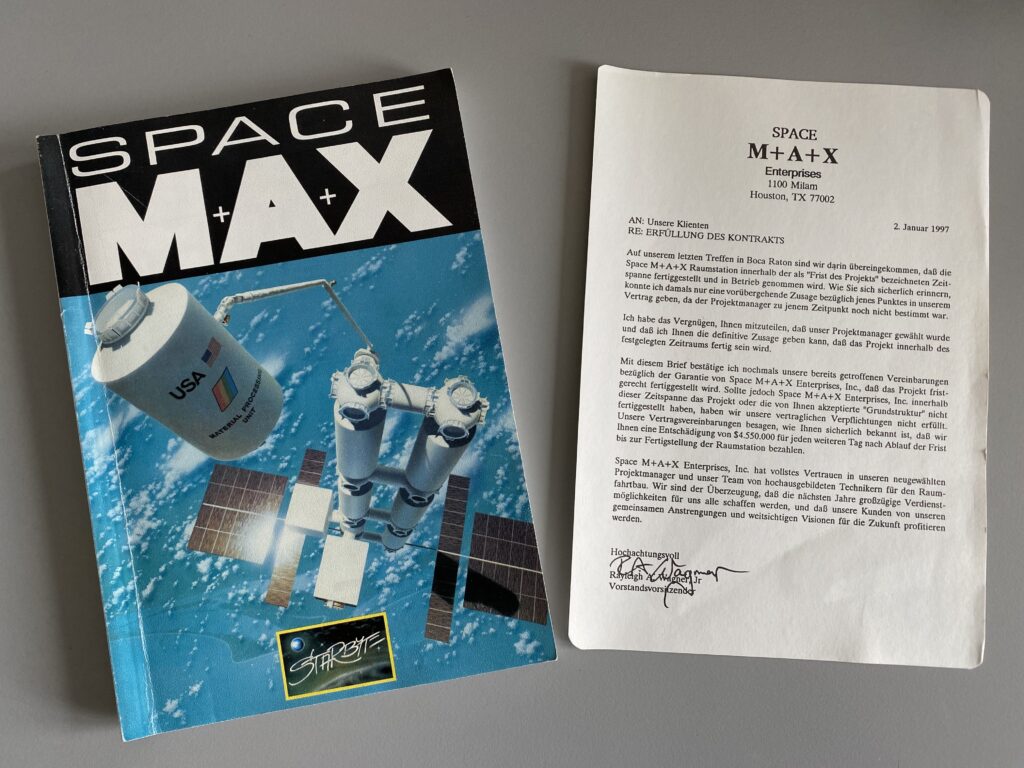
Figure 17: Cover of the booklet for Space MAX (1992) in color and a letter from the president of the board that states your hiring for the job of a project manager. Photo: Suter
After all the connections have been explained, the concrete manual of the game follows from page 95 on – again mainly textual and well structured. Finally, the specifications for the two systems PC and Amiga follow, as well as the appendices and a list with explanations of the acronyms used in the game. This brings us to a full 140 pages, printed in good quality on acid-free paper and bound by a color cover. Included, by the way, is a letter from the CEO of Space MAX Enterprises informing NASA that a trusted project manager has been hired and pledging to complete the space station on time (Figure 15). This separate staged letter skillfully completes the framework of the game’s story for the player. It’s a shame that this remained the last complete strategy game from Starbyte, as the company was dissolved soon after.
Downsizing
Traps’n’Treasures (1993) was initially published by Starbyte Software. The English version was released in 1994 by the British publisher Krisalis Software. While as the German manual by Starbyte is a sizeable 16 pages, the English version was shrunk to 8 pages. However, the English version comes in a well-planned professional layout and features an extra introduction that tells the player more about setting and what their role is.
The German version gives an impromptu and handmade impression, the pages all have a frame and titles in a gothic font like Germanica. And it starts with telling the player right away where their men are imprisoned by Red Beard. After this, the GUI gets explained, and then Joystick navigation and keyboard. Finally, we get to know important level elements and what the shop has to offer. So, the manual is somewhat downsized to explaining the elements of gameplay. After a short story summary as extra introduction (missing in the German version), the English version lays out the same information on just 4 pages. It is obvious that a large part of the story has been moved into the game itself. Thus, the game begins with quite a bit of text telling the back story of Jeremy Flynn, the captain of the Poseidon and his 37 sailors. The diary text of Flynn scrolls quickly from the bottom to the top of the screen automatically – and that for 2 minutes.
This trend of downsizing the manuals continued further. An important purpose of instruction manuals was to enhance the game’s lore and provide background information. As we have seen in the mentioned examples, manuals were often filled with additional details about the game world, its characters, and the story, offering players a deeper understanding and immersion in the game. This aspect of instruction manuals was where they truly excelled and showcased their value.
But their foremost and vital role was to teach players how to play a game. The mentioned games did this extensively, especially the economic simulations that could not rely on pictures and animations that much and impressed with a complex GUI. The manuals provided essential information on game mechanics, controls, and objectives. But, over time and with the rise of tutorial missions and in-game help systems, the task of teaching players how to play has been largely transferred to these interactive elements. And the instruction manuals became more and more obsolete.
And out they go – or not?
Looking back from today, you might state that the primary purpose of instruction manuals had become obsolete due to in-game information, tutorials and sometime later internet-guides, -videos and -walkthroughs. But what has been lost is more than just a chunky booklet, it is the art form of making an instruction manual that has an own value as a means of extending the game’s lore and providing additional tips, since instruction manuals were often crafted with care, featuring beautiful artwork and clever ways of presenting information.
“When done right, manuals felt like an extension of the game world itself. The pages could be designed to echo the setting, they could include maps, and they sometimes even gave context to the characters and world not found in the game. Of course, they often just contained pages of legal jargon, control guides, and told you how to turn on the console. But sometimes they went to extra mile, and it would be nice if they could again.” (Nelson 2021)
But physical game manuals with all kinds of information were produced much longer than we might think. Even though most of them became rather redundant through tutorials and in-game help, they were created for most boxed games up to around 2010. In the 00 years, PS3- XBOX360- and Wii-Games still had booklets with at least some tutorial, story, and extra information. But the next generation came without them. Ubisoft started saving money and claiming to become eco-friendly with abandoning printing manuals and publishing game information, stories, and extras online on their website in 2010. They stuck to it and other big publishers followed soon. But there was a big hesitation in the game industry to get rid of the booklets completely. Nintendo kept up the manual goodies and only stopped it with the release of the Nintendo Switch.
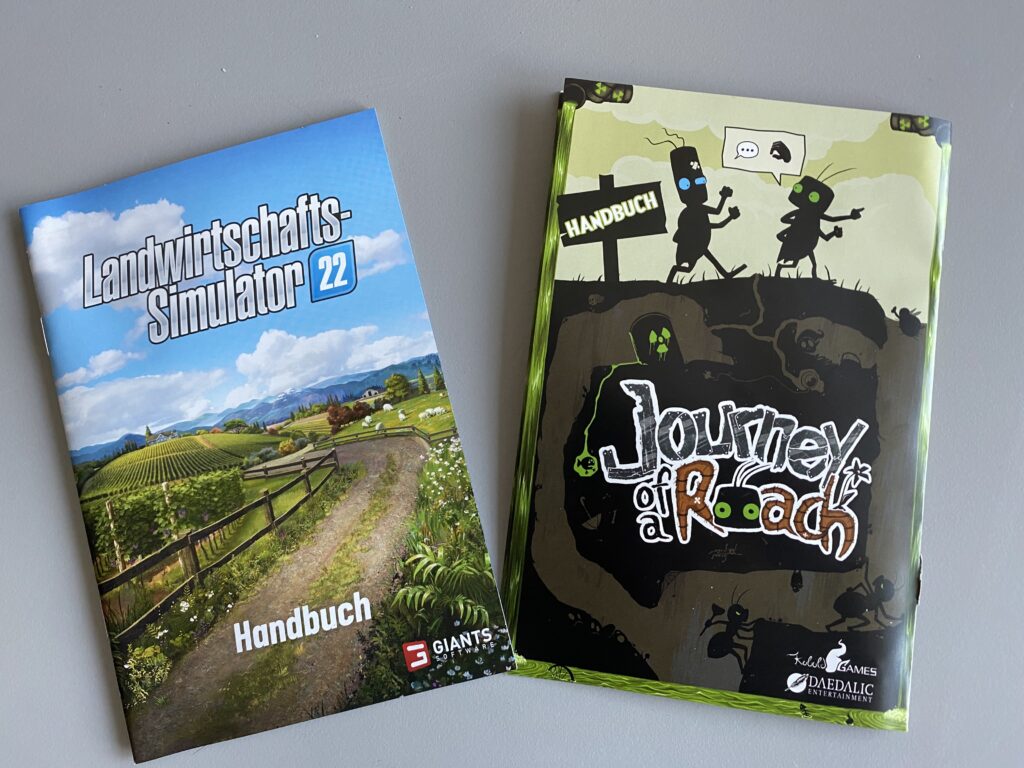
Figure 18: More recent booklets for the Farming Simulator 22 (2022) and Journey of a Roach (2013) were printed in color on glossy paper. Photo: Suter
Some Swiss games came with booklets even later than 2010. Journey of a Roach (2013), an innovative adventure game developed by Kobold Games and published by Daedalic had a classic twelve-page instruction manual in color that came with a description of the story, the menu, and the controls, nicely illustrated with character drawings and sketches for the UI and for the controls. However, the booklet seems to be put together in a hurry: The title page mistakenly features an ad for Daedalic’s popular game Deponia and only page 2 is the real cover page for Journey of a Roach. And the Farming Simulator seems to continue the tradition of printed manuals with some of their many boxed versions. The German version Landwirtschaftssimulator 22 (2022) comes with a 26-pages ‘Handbuch’. The color printed handbook starts with basic explanations for installations, an extensive list of all controls via mouse and keyboard and via controller. Then, it describes the player’s first steps and the Head-up-Dispay. On five pages it tells you the basics of farming, it continues with six pages of farming knowledge, three more pages for how to make money in the game and how to buy and look after your big important agricultural machines. Finally, there are two pages with information on multiplayer and mods. It really is a handbook that teaches unfamiliar players about all the possibilities in the simulation game. It compares to earlier booklets like Space MAX (1992) and offers the player a service they might not need unless they are new to the game.
„It’s funny, but I have a deep love for game-paratext that ultimately goes back to my childhood,“ says Eugen Pfister (2023), describing his journey back to the nostalgic world of paratexts. He remembers „big manuals“ and „maps of fantastic countries folded several times.“ For him, „touching, haptics […] was not only a matter of course, [but] […] a central moment of the gaming experience“ (translated by author). He formulates this under the impression of the practically disappearing printed inserts for videogames, because now less than 10 percent of games are still sold physically on carrier media and in boxes. For some years now, almost the entire distribution of games has taken place virtually via downloads and streaming. But that doesn’t mean that paratexts have disappeared altogether. They can now simply be found in the Internet with publishers, developers and, above all, on the streaming and sales platforms for games.
The game Far: Lone Sails (2018) by the Swiss developers Okomotive offers a very short intro of five lines on its Steam page. It is formulated as a minimal story and gameplay instruction. While this is standard on Steam, the info about the game further down is also kept very concise. The game itself then contains neither an intro, nor a tutorial and lets the players start playing immediately. So, you have to gather info and story in the game. The Wandering Village (2022) by Stray Fawn Studio, on the other hand, already offers a lot of information about the game world and its structure on their Steam page. Steam is a very popular contemporary platform for publishing and marketing independent games.
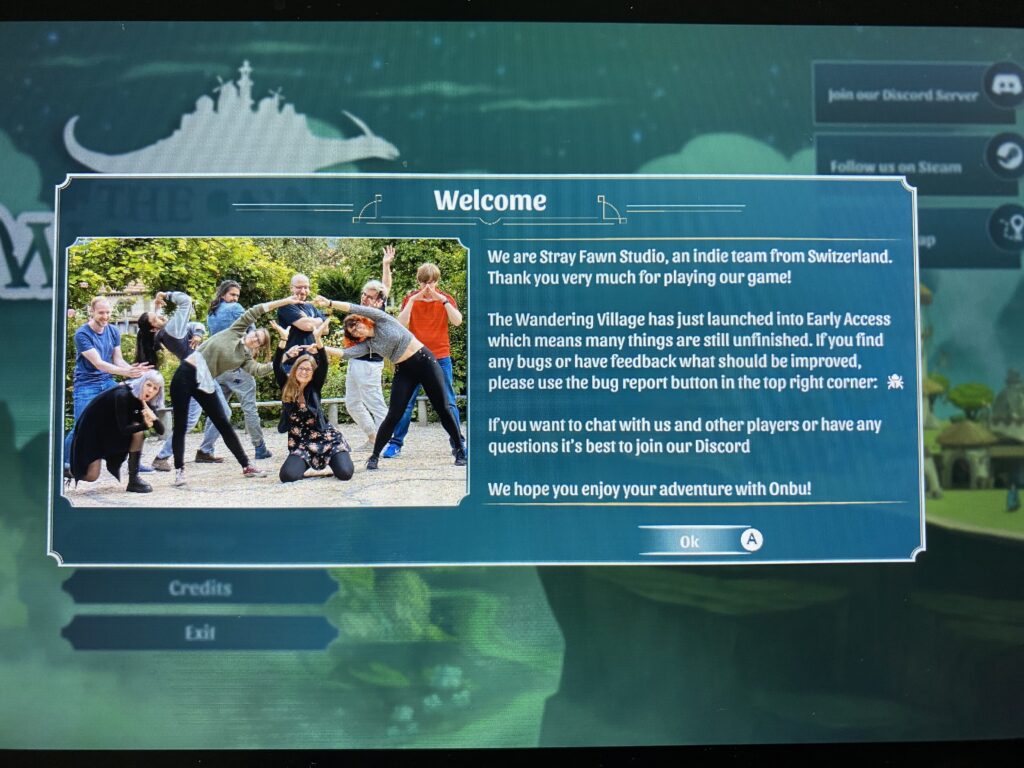
Figure 19: The Wandering Village (2022) by Stray Fawn Studio offers a lot of information about the game and conncects the players in a large online community. Over the Steam page and Discord forum channels, there is also a fruitful communication between game devs and players established. Schreenshot: Suter
As an Early Access game, The Wandering Village also offers its own Steam News Hub, where numerous events can be found, as well as access to a huge community that is involved with the game, both on the Steam platform and on the gaming chat platform Discord. These include walkthroughs of some areas of the game, for example, which have been written or filmed by players. The expanded virtual possibilities open up entire worlds of information about individual games as well as complex communication possibilities for the players and above all between the developers and the players, which also lead to new creations such as expanded content for the game or, for example, fan drawings. The Manual Instruction Booklet has exploded here and become a very dynamic and multifaceted communication tool – more than a worthy replacement.
See also:
Part 1 — A serious manual — (Link)
Part 2 — Story Booklets — (Link)
Beat Suter (CH-Ludens, 21. September 2023)
Literature for all three parts:
Games:
Black Gold (1992) (Amiga, Atari ST), Starbyte, Starbyte.
Clown-o-mania (1989) (Amiga, Atari ST), Starbyte, Starbyte.
Crack (1988) (Amiga, Atari ST), Linel, Linel.
Dugger (1988) (Amiga, Atari ST), Linel, Linel.
FAR: Lone Sails (2018) (PC, Mac, Steam). Okomotive, Assemble Entertainment.
Hannibal (1993) (Amiga, PC), Starbyte, Micro League.
Journey of a Roach (2013) (PC, Mac), Kobold Games, Daedalic.
Landwirtschaftssimulator (2022) (PC, Mac), Giants Software, Giants Software.
Necronom (1991) (Amiga), Lunatic Software, Linel.
Rings of Medusa (1989) (Amiga), Starbyte, Bomico.
Rolling Ronny(1991) (Amiga, Atari ST), Starbyte, Virgin Games.
Space MAX (1992) (Amiga, Atari ST, PC) Starbyte, Starbyte.
The Wandering Village (2022) (PC, Mac, Steam), Stray Fawn Studio, Stray Fawn Studio.
Traders (1991) (Amiga, Atari ST), Linel, Merit Games.
Transworld (1990) (Amiga, PC), Starbyte, Starbyte.
Traps’n’Treasures (1993) (Amiga), Starbyte, Starbyte.
Winzer (1991) (Amiga), Starbyte, Starbyte.
Manuals:
Black Gold (1992), Manual / Anleitung. Bochum, Starbyte Software.
Clown-o-mania (1989) Manual / Anleitung. Bochum, Starbyte Software.
Dugger (1989). Manual / Anleitung (with cartoons by K. Bihlmeier). Vaduz: Linel.
Hannibal (1993). Manual / Anleitung by K.J. Kraft. Starbyte Software.
Hannibal – Instructions (1993). In: Lemonamiga, Doc by Acid Queen and Basel Evil/Faith, (https://www.lemonamiga.com/games/docs.php?id=768), (01.05.2023).
Journey of a Roach (2013). Anleitung. Hamburg: Daedalic Entertainment.
Landwirtschaftssimulator (2022). Anleitung. Zürich, Erlangen: Giants Software.
Necronom (1991). Manual / Anleitung. Vaduz: Linel.
Rings of Medusa (1989). Manual / Anleitung. Bochum: Starbyte Software.
Rolling Ronny (1991). Manual / Anleitung. Bochum, London: Starbyte Software, Virgin Games.
Space MAX (1992). Manual / Anleitung. Bochum: Starbyte Software.
Traders (1991). Manual / Anleitung. Vaduz: Linel.
Transworld (1990). Manual / Anleitung. Bochum: Starbyte Software.
Traps’n’Treasures (1993). Anleitung. Bochum: Starbyte Software
Traps’n’Treasures (1994). Manual. Rotherham: Krisalis Software.
Winzer (1991). Anleitung. Bochum: Starbyte Software.
Literature:
Campbell, Stuart (1992). Necronom. Review. In: Amiga Power, January 1992, p. 92.
IGN Staff (2010). The Death of the Manual. IGN editors discuss (and mourn) the fading fate of the manual. In: IGN, April 22, 2010, updated June 14, 2012, https://www.ign.com/articles/2010/04/22/the-death-of-the-manual (26.05.2023).
Nelson, Will (2021). The lost art of the video game manual. In: NME Gaming. 22nd November 2021. (https://www.nme.com/features/gaming-features/the-lost-art-of-the-video-game-manual-3088607).
Pfister, Eugen (2023). Paratext! Kindheitsanekdoten. In: GAIN. Play, Meet, Think. Berlin. 20/2023, p.68 – 69.
Reilly, Jim (2010). Ubisoft Removing Paper Game Manuals. IN-game digital manuals tob e included in future titles. IN: IGN, April 19, 2010, updated: May 9, 2012, https://www.ign.com/articles/2010/04/19/ubisoft-removing-paper-game-manuals (26.05.2023).
